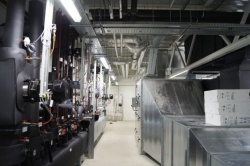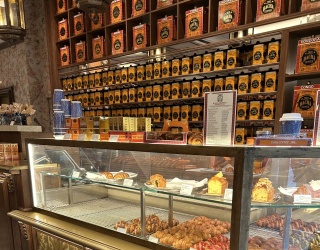
While the ambiance, the showcased merchandise and the lighting catch someone’s eye, climate technology happens behind the scenes. Not until something is not working right, do you notice it: it gets too hot or too cold, people complain about drafts, the lack of fresh air or irritating noises.
Heating and cooling are important cost drivers in business. Die EHI Retail Institute study “Energy Management in Retail 2010“ (“Energiemanagement im Einzelhandel 2010“) revealed that in the food retail industry over 55 Euros per square meter of sales floor are incurred by energy, of which cooling costs at 44 percent cause the largest electricity consumption. In non-food retail on average only 31 Euros per square meter of sales floor need to be drummed up for energy. The largest portion at 65 percent is caused by lighting costs.
According to the EHI Retail Institute, retail‘s willingness to invest has most profoundly changed in the areas of building services engineering and construction. Just short of 28 percent of surveyed retailers were willing to invest in 2008, whereas in 2010 at just under 53 percent that number nearly doubled. An energetically optimized building, innovative building services engineering or the use of regenerative energies provide for high energy- and ecological efficiency and are therefore the starting point in energy optimization for many companies. In non-food retail, even longer amortization periods of up to five years and more are being accepted in these cases.
Property managers know: While heating is expensive, cooling is even more expensive. Yet the customers are supposed to feel comfortable and should gladly want to come back to the store and employees should jauntily be able to perform their tasks. Heating and cooling engineers are in demand, because at the supermarket, in the fashion store, at the specialty shop or department store you cannot just quickly open a window like you do at home to get some fresh air in. Heating and cooling engineers differentiate between ventilation and air conditioning with air ventilation through outdoor air, from equipment that circulates ambient air without ventilation function.
Air from outside – necessary and difficult
One important gateway for outside air is the entrance. For grocery discount supermarkets, lobbies with two successive doors have stood the test of time. Fashion boutiques like to keep their clothing articles visible towards the entrance of the store even during the cold season, so passersby will find their way into the shop easier. Here air surge equipment is being used, which creates a hot-air curtain that keeps the cold outside air outside. Admittedly, critics deplore the high energy expenditure.
At home you know how annoying drafts are. Drafts arise if differences in air pressure are abruptly equalized. The causes for drafts are differences in temperature or air humidity. The larger the building, the more wind conditions also play a role. Luv and Lee – upwind or downwind – they cause pressure differences. Solar radiation as well as cooling down of glass facades during freezing temperatures also has an effect on indoor temperature. And of course heating also impacts the air ratio. People add to all this as well. The pyramids in Egypt have kept the rich coloring of their mural paintings over millenniums, but are now threatened by the increasing air moisture from visitors’ breathing. In retail, the number of guests often fluctuates even during the course of the day. Ventilation technology needs to balance all this.
Many factors affect indoor temperature
What ordinary people usually don’t know: “Bad air“ is not caused by a lack of oxygen, but primarily by an elevated CO2-concentration. Chemist and founder of modern hygiene Max von Pettenkofer discovered this in the year 1858. The outer air contains 0.03 volume percent CO2. A person exhales air with a CO2 concentration of about 4 volume percent. Without the exchange of new outside air, the CO2 concentration in inhabited rooms would quickly increase. While an elevated CO2 concentration is not immediately posing a risk to health, it nonetheless results in fatigue, indisposition, concentration difficulty and headaches.
While heating elements in private households are often located under the windows, in retail shop windows should remain clear for decorations. What’s more, the sales floor is normally too large to be only heated from the perimeters inward. That’s why oftentimes you heat and ventilate through the ceiling. Heat however rises to the top, so that floor heating is more effective. In a EuroShop interview, Jan Kröger, Managing Director of heating and cooling company Hafner-Muschler, advocates concrete core tempering for new buildings. ”The great thing about it is the low flow temperature of the heating system. “
Often the store layout causes additional problems for heating and cooling engineers. Store aisles interfere with free air circulation and the cooler air from the produce section or open deep freezer cabinets or multi-deck refrigerated cabinets whirl the warm ambient air around. The merchandise also has an impact. While fragrances from the drugstore shelves might be pleasant, solvent particles from the home improvement area or impregnated textile odors are certainly not.
Regional building regulations determine requirements for air ducts, air pipes and fire traps. In the event of a fire it must be prevented for smoke and flames to cross over to other parts of the building. Ventilation systems don’t operate silently; engineering standards also apply here. Ventilation lines primarily create whistling and hissing sounds through air friction and swirling on structural parts. Due to intake and exhaustion of air, dust, bacteria and viruses can accumulate in the ventilation system. Filters and meticulous maintenance are essential.
Fragrance – a new trend
Still a young chapter in climate technology is fragrance marketing. Scents are subconsciously noticed and affect the brain at lightening speed. The aroma of bread makes you hungry, while the scent of leather appears classy. The use of fragrance however is controversial, since critics fear consumer manipulation. Yet wherever fragrance diffusers are being used, heating-and cooling engineers will again be in great demand. And once again it will be just like it always is in their business: hardly anybody notices if all goes well.
René Schellbach, First Publication: EuroShop.de








